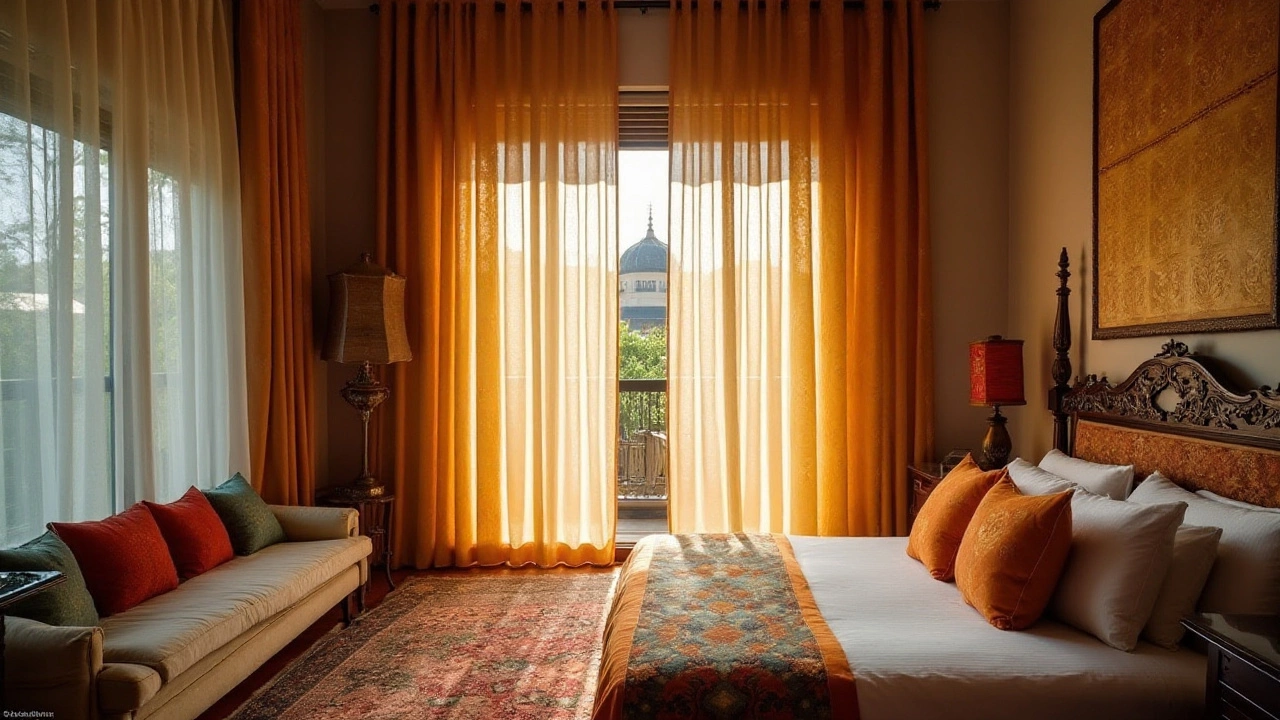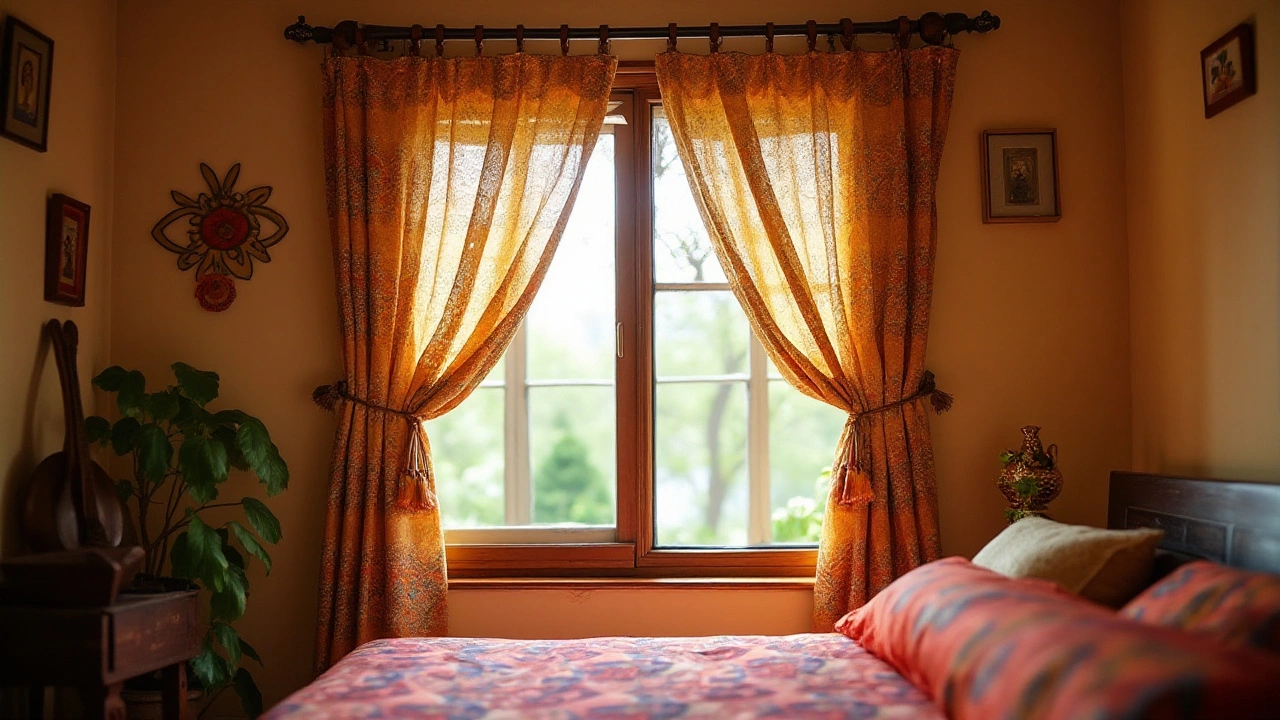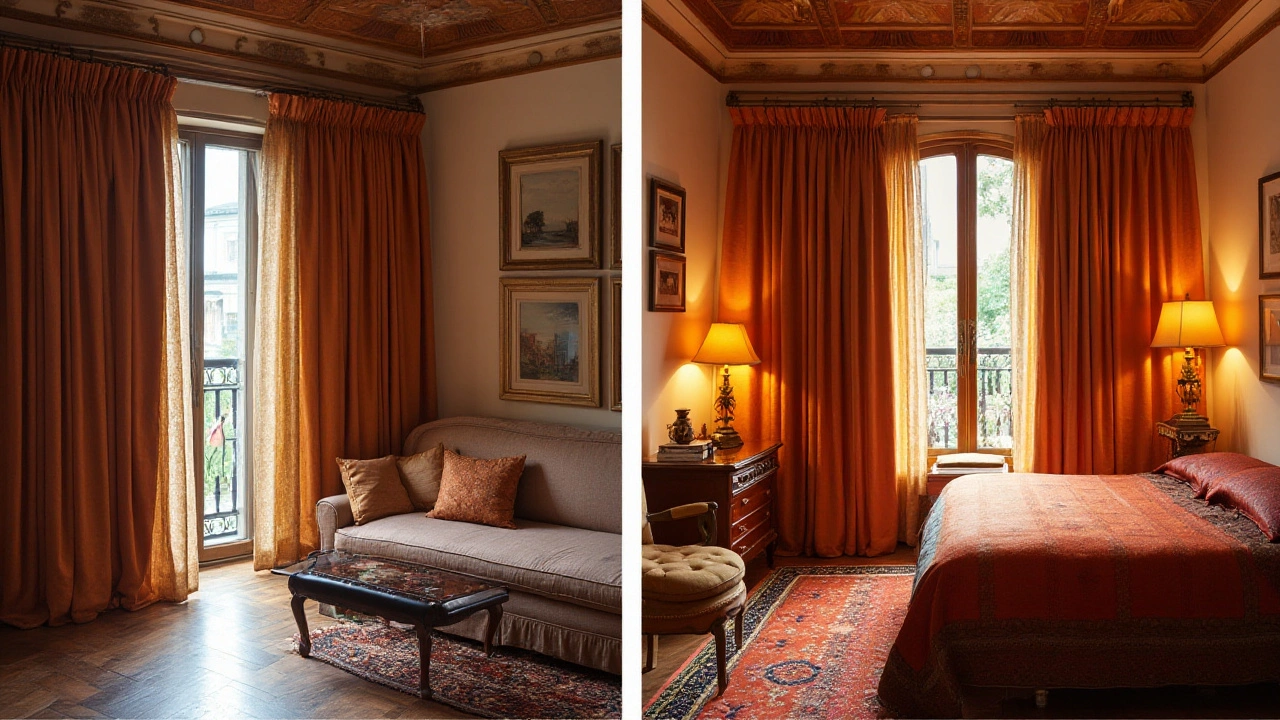The Great Curtain Debate: Long vs. Short for Your Bedroom

When it comes to dressing your bedroom windows, the length of the curtains is a choice that goes beyond just decor. Curtains can influence a room’s light, mood, and perception of space. So, should your bedroom curtains be long and luxurious or short and sweet?
This decision isn't as straightforward as it might initially seem. Some prefer the elegance and dramatic effect of floor-sweeping drapes, while others lean towards the practicality and modern appeal of a shorter style. Both have their merits, but which is right for your bedroom may depend on various factors, including your personal style, the room’s dimensions, and the overall atmosphere you wish to create.
In this article, we will explore the different aspects and benefits of long and short curtains, provide tips for making the best choice for your space, and examine how these options can complement or transform your bedroom.
- Understanding Curtain Functions
- The Appeal of Long Curtains
- Benefits of Short Curtains
- Room Design Considerations
- Choosing What Works for You
Understanding Curtain Functions
Curtains often serve as the unsung heroes of a bedroom, playing a dual role in aesthetics and functionality. At their core, curtains are designed to manage light and privacy, two critical elements that define the comfort of your personal space. But beyond these fundamental purposes, curtains contribute significantly to the room's ambiance, insulation, and even acoustics. Imagine waking up on a sunny morning, only to discover that your curtains are doing their best to let in just enough sunlight while maintaining your privacy, offering you a perfect start to the day.
Light management is a primary concern when choosing bedroom curtains. These window treatments allow you to control the flow of natural light entering the room. Long, heavy drapes might be ideal if you crave darkness for a restful sleep, effectively blocking out any intrusive street lights or glaring sunrays. Conversely, lighter shades or shorter styles can gracefully filter sunlight, creating a warm, inviting atmosphere without overwhelming brightness. Privacy is another crucial aspect, and curtains provide a barrier against prying eyes, especially in urban settings where space is limited.
Moreover, curtains contribute to the room's thermal efficiency. During colder months, long curtains, particularly those made of thick materials, serve as an extra layer of insulation by trapping heat inside, reducing energy bills and maintaining a cozy environment. In warmer climates, lighter fabrics or short curtains enable better air circulation, allowing your space to remain cool and comfortable. A well-chosen curtain can thus impact room temperature meaningfully, adding an extra layer of practicality to your decor.
Sound absorption is another less obvious function of curtains, especially worth considering in bustling neighborhoods. Heavy or layered curtains can significantly reduce noise pollution, transforming your bedroom into a tranquil sanctuary. This acoustic dampening quality is particularly advantageous for those who crave uninterrupted peace during their downtime. A study published in the 'Journal of Architectural Engineering' highlights that curtains can absorb up to 40% of sound energy, offering an additional layer of serenity to your space.
"Curtains hold the power to transform not only the look but also the feel of a space," says renowned interior designer Sarah Iverson. "Choosing the right curtains involves considering their thermal, acoustic, and visual impacts, ultimately deciding how they enhance your home’s atmosphere."
In creating the desired atmosphere, long curtains can add a touch of grandeur and drama, creating an impression of height and elegance. Meanwhile, short curtains lend a more contemporary and relaxed feel, perfect for those who prefer minimalist or clutter-free aesthetics. Decision-making, therefore, isn't just about personal taste. It requires thoughtful consideration of the room’s purpose, orientation, and existing decor, ensuring harmony with other elements of your bedroom.
The Appeal of Long Curtains
Long curtains have a way of transforming any bedroom into a space that feels cozy yet grand. The sweeping, floor-length drapes are reminiscent of opulent settings seen in classic films or royal residences. One major benefit of opting for long curtains is their ability to create the illusion of height. Rooms often appear taller when curtains are installed from ceiling to floor, which is particularly beneficial for bedrooms with low ceilings. This simple design trick can draw the eyes upward, adding sophistication without any complex renovations.
Another appealing aspect is the elegance and drama they bring into the space. Long curtains often create a sense of formality and grace, making them ideal for traditional or formal bedroom settings. When paired with lush, rich fabrics like velvet or silk, they can infuse a luxurious touch, instantly elevating the room's ambiance. Not to mention, when chosen in a complementary color or pattern, these curtains can act as a stunning focal point.
Moreover, there are functional benefits to consider. The extensive fabric coverage better insulates the room against drafts and can significantly reduce heat loss through windows in colder months. The added material also helps in soundproofing the room, which is a blessing for light sleepers or those living in noisy neighborhoods. This practical advantage makes long curtains a desirable option in climates where insulation is crucial.
Many interior designers advocate for longer drapes due to their versatility. A well-chosen curtain can seamlessly blend with both contemporary and classic decor styles. Anne Harris, a renowned interior decorator, once said,
"Long curtains have a unique capacity to act as both a complement and a spotlight. They meld into the background while simultaneously providing a grounding elegance."Her insight highlights the adaptable nature of these window treatments, which can be effortlessly switched from a bold statement piece to a subtle frame as needed.
Some facts to back up the effectiveness of long curtains include studies that show window treatments, like heavy drapes, can cut heat loss from a room by as much as 25%. Bedroom curtains play a vital role in managing natural light, and long ones offer the flexibility to maximize or minimize sunlight as desired. This feature also enhances privacy, enabling you to keep prying eyes at bay without sacrificing style. Compared to shorter alternatives, long curtains allow for more inventive styling approaches; you can tie them back to allow sunlight or let them flow freely for added privacy.
The challenge, however, is ensuring they suit the dimensions and style of the room. It’s essential to measure your windows and consider the result you want to achieve. A slight puddle effect, where the curtain fabric lightly touches the floor, can add a touch of romance, while precisely cut drapes can exemplify clean lines and modernity. The potential of long curtains is vast; whether you're aiming for a dramatic theater-like entrance or a serene personal retreat, the choice of curtain length can help achieve that ideal space.

Benefits of Short Curtains
Short curtains often fly under the radar when it comes to window dressing, yet they possess a number of compelling advantages. For starters, they are more practical in homes where furniture is placed close to windows. Short curtains won't obstruct heaters or radiators, ensuring warm air circulates effectively. This is especially important in older homes where central heating may be less efficient. Additionally, they're much easier to maintain, saving you the hassle of constant cleaning that long curtains often necessitate due to their contact with the floor.
Let's talk about safety, particularly if you have young children or pets. Short curtains are less likely to be tugged at or caught up in playful antics that could lead to accidents or damage. Given their length, they also pose less of a strangulation risk, which is a real concern for many parents. In apartments or houses prone to dust and dirt, having short curtains means that sweeping and vacuuming are less burdensome tasks, freeing up more of your time for other activities or simply relaxation.
From an aesthetic perspective, short curtains can project a modern, minimalist look. In rooms with low ceilings, they can help create an illusion of elevation by framing windows neatly. A bedroom curtain that aligns with the sill or slightly below can offer a crisp, tailored look. This might align well with contemporary design trends that favor simplicity and function over ornate detail.
"Home is the nicest word there is," said Laura Ingalls Wilder, capturing the essence of personalization that short curtains offer by fitting gracefully into the individual style of your home.
Moreover, for those who enjoy frequently changing their decor or might be on a budget, short curtains are accessible both in terms of variety and price. Because they use less fabric, they tend to be cheaper, allowing for seasonal updates without breaking the bank. Their lighter aesthetic presence can also allow for bolder patterns and colors that might overwhelm in a longer format. In terms of environmental impact, these curtains often require less material and therefore can be a more sustainable choice.
Functionality doesn't take a backseat, either. Short curtains can be easily adjusted or paired with blinds for light control. In darker spaces, they allow more ambient light to fill the room, lending a brighter feel to your bedroom surroundings. Not to mention, they are a breeze to switch out or layer with other window treatments like valances or panels, offering versatility to the decorator at heart. This adaptability should not be underestimated when considering the energy savings from optimized lighting and heating conditions.
Room Design Considerations
When deciding whether long or short curtains are best for your bedroom, it’s essential to factor in the room’s overall design and architecture. The layout, ceiling height, and window size can greatly influence this choice. For instance, in spaces with low ceilings, long curtains can draw the eye upward, creating the illusion of height and grandeur. Conversely, in rooms with large windows and a view to die for, shorter curtains might be preferred to avoid obstructing any natural light or scenic views.
The style of your bedroom and its furnishings should also play a critical role in your decision. If your bedroom leans towards a modern, minimalist design, short curtains can emphasize clean lines and a contemporary vibe. In traditional spaces, long, heavy drapes might add an element of timeless elegance and sophistication. Think about the fabric, pattern, and color too—these factors can help your curtains tie the whole room together. Consider using neutral colors for a versatile look or bold patterns for a standout statement.
Practicality Meets Aesthetics
Let's be practical: there’s more to curtains than meets the eye. In addition to their visual appeal, they also serve functional purposes, like controlling light and providing privacy. For those who enjoy sleeping in complete darkness, blackout curtains, undoubtedly longer ones, can be an excellent option. These curtains block out sunlight proficiently, making them ideal for night owls. Conversely, for those who appreciate an ambient glow in the mornings, shorter curtains that allow some light to seep through can offer the perfect balance between light and privacy.
Bedroom curtains, whether long or short, can significantly impact how a space feels. According to design guru Nate Berkus, "Curtains are like the eyebrows of a room—they finish the space." This notion speaks volumes about the intricate role curtains play in interior design. Their length, therefore, not only contributes to the room's aesthetic appeal but also has practical considerations—insulating the room from cold drafts in winter or shielding it from scorching heat in summer. Insulation properties are particularly beneficial when choosing a curtain type, such as thermal curtains.
"Curtains are not mere window dressings; they are personality statements," Berkus adds.
Before making a final choice, consider drafting a quick sketch of your space. Visualizing different curtain lengths can sometimes reveal surprising preferences. Get a tape measure and some curtain samples to drape around the windows temporarily. This hands-on approach can offer more insight than mere speculation, helping homeowners make an informed choice based on clear visual and functional advantages.

Choosing What Works for You
When it comes to selecting bedroom curtains, the decision between long and short ones is sometimes more nuanced than it initially appears. Each length carries its own set of advantages and brings a unique flair to the room. Long curtains are synonymous with grandeur, often adding a touch of sophistication, while short curtains can offer a casual, cozy atmosphere that feels welcoming and relaxed. To determine which style suits your space best, consider your lifestyle, maintenance preferences, and how you wish the room to function. For example, long drapes might not be the best choice for pet owners, as they collect more dust and fur, but they're fantastic for keeping out light when you want to sleep in during weekend mornings. Conversely, if you frequently open and close your windows for fresh air, short curtains can offer easier access and less hassle when opening windows.
Beyond personal comfort and practical considerations, it's crucial to think about how your choice will impact the room's aesthetics. If enhancing the perceived height of your ceilings is a priority, opting for long curtains could be ideal. They create vertical lines that draw the eye upward, making the room appear larger and more elevated. On the other hand, short curtains may highlight beautiful window trims or heating elements like radiators, which could be desirable in rooms with charming architectural details. Before making a choice, remember that the room's existing design and architecture play an essential role; a stark, minimalist space might call for the drama of longer curtains, while a quaint, tiny bedroom might benefit from the simplicity of shorter curtains.
Sometimes, mixing curtain lengths in different parts of your home can also be a design strategy worth considering. For instance, according to renowned interior designer Sarah Richardson, "Layering various curtain lengths and styles adds depth and interest, allowing for a versatile approach to window treatments."
"There's no one-size-fits-all answer when it comes to curtain lengths," says Richardson. "Each room's unique qualities should guide your decision for the most cohesive look."Using this approach in your bedroom can lead to a more tailored and flexible design, enabling you to play with textures, colors, and lengths to best suit your mood and the time of year.
Of course, budget considerations also come into play. While longer curtains may require more fabric and, thus, could be more expensive, they often offer greater value by being more versatile with design changes over time. Short curtains, though often less costly, can limit shifts in decor due to their more stationery visual effect. It's essential to weigh how much you're willing to invest in changing curtains with varying decor trends in mind. Often, people opt to change curtains seasonally to refresh their living space — a practice that can become cumbersome and costly with longer options.